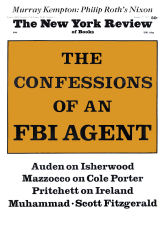Aldridge is the Saint George of journalism. He makes a grand fetish of slaying the paper dragons of literary fashion. Death to the sellouts—that’s his portentous motto. In this collection of review-essays, covering some twenty-five years of work, though the rhetoric changes from decade to decade, the self-styled “evangelical zeal” and “moral purity” remain aloft throughout. Discussing the postwar novelists in the late Forties, for instance, he has all the earnestness of the editor of a college newspaper determined to make his mark: “In comparison with the innocent boys who set out, more than twenty years earlier, to save the world for democracy, the young men who went into the second war seemed terribly aware…. They came to consciousness in the midst of breadlines, strikes, and milk riots.”
By the mid Fifties, we see he has grown more sophisticated and can sprinkle names with the best of us: “Mr. Morton Dauwen Zabel, in his excellent short study of Graham Greene, could well have been thinking of Danny’s problem along with the problem of what I have been calling the ‘Bovarist vacuum’…” (Danny is a character in Farrell.) No doubt responding to the whirling Zeitgeist, by the mid Sixties he becomes a publicist of sorts, as witness the dizzy encomium for Why Are We in Vietnam?: “Hence, behind every apocalytic orgasm is an apocalyptic defecation…. The route to salvation is thus from anus to phallus, from organic excretion to orgasmic ecstasy. If there is in fact a Great Chain of Being, Mailer’s advice would obviously be to pull it.”
This later style is so scathelessly a parody of itself that one would not wish a word changed. Recently Aldridge decreed the cult of youth to be the new sacred monster. What more can one say? He writes about Porter and Frost, Barthelme and Styron, Dos Passos and Hemingway, politics and culture. Aldridge is a critic of middle-seriousness who takes himself very seriously indeed.
Recent investigations in Brazil have revealed that primitive Amazonian Indian tribes were, and perhaps still are, victims of a long-standing policy of systematic genocide, torture, and slavery by representatives of powerful private political and economic interests operating with the open complicity of the Service for the Protection of the Indians, the official governmental agency charged with defending Indian rights and improving their conditions, sometimes called the “Service for the Prostitution of the Indians.” The Brazilian government has reluctantly acceded to these findings and some SPI functionaries have been punished or dismissed, but the fate of the remaining Indians (about 200,000; once four million) remains problematic.
Bodard, who has conducted an extensive independent inquiry into the atrocities, believes that “civilization” views the Indians as “redundant,” ignorant savages standing in the way of “progress,” unassimilable misfits (“Annihilation is always way ahead of conversion,” remarked one of the men he interviewed); and remarkably no one seems to care. The most sensational part of this book—notwithstanding the revolting and numbing descriptions of the horrors the Indians have suffered—is the repeated allegation that American concerns in Brazil have tacitly supported or even fostered exploitation and extermination. “An American circuit,” one Brazilian intellectual told Bodard, “from Bethlehem Steel to Bethlehem Steel. Nothing but for and by Bethlehem Steel.” This is a shocking book which should stimulate immediate congressional investigation into the charges of US involvement in the massacre—surely the obvious historical parallels cannot be missed or evaded.
The short, desperate life of Janis Joplin: “gutsy, ballsy, funky,” she came on with “the wobbling fury of a derailed train.” Dalton, who traveled with her during the last months of her life—to bars and motels and airports and aboard the Festival Express from Toronto to Calgary—has patched it together from her high-school days in Port Arthur, Texas, to the Haight-Ashbury street scene to the Monterey Festival where she exploded into stardom, and to the L.A. motel where she died. Fleeing her middle-American Republican upbringing she covered herself with “cheap vinyl defenses,” outrageous floozy feathers and glass beads, offering all comers “another little piece of my heart,” never reconciled to being a superstar. Armed with a song and smack and a big bottle of Southern Comfort, defying the “Great Saturday Night Swindle,” Janis was the Kozmic Blues and, like her soul-sister Zelda Fitzgerald, she knew she was destroying herself. (She said of Jimi Hendrix’s death, two weeks before her own, “Goddammit, he beat me to it.”)
Dalton is a modest biographer who knows that he cannot get past the myth of Janis precisely because she spent her whole life erasing historical reality and replacing it with myth. Nevertheless the book is laced with Janis’s boozy asides, her raunchy “hi-ya boys” style (“so that I can get laid”), and the gaudy and sad reminiscences of the musicians who knew her best. The “lesion of identity” between protean goddess and the scraggly, vulnerable waif is there, sure enough. Excerpts from Rolling Stone reviews of concerts and record albums, photographs, and song lyrics are included.
Advertisement
(Notice in this section does not preclude review of these books in later issues.)
This Issue
January 27, 1972



